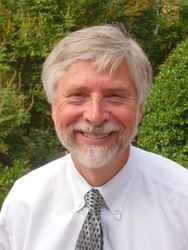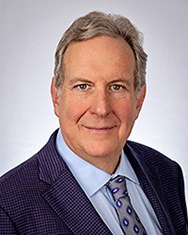This Chair’s Corner episode features Dr. Sam Cykert, Professor of Medicine, Associate Director of Medical Education for NC AHEC Program, and Clinical Director of the NC Regional Extension Center for Health Information Technology. Dr. Falk and Dr. Cykert discuss the research project “Heart Health Now” which seeks to improve heart health of patients in primary care practices in North Carolina.


If a patient whose blood pressure isn’t under control, or who’s not on a statin cholesterol medicine.. by starting that medicine you can reduce the event rate by as much as 25 percent in a year or two for these high risk patients.”-Dr. Sam Cykert
Topics in this conversation include:
- What is “Heart Health Now?”
- How do you calculate risks for heart health?
- How does this tool help reduce risk?
Falk: This is Ron Falk for the Department of Medicine at the University of North Carolina. Welcome to the Chair’s Corner. Today we welcome Dr. Sam Cykert who is a Professor of Medicine in the Division of General Medicine. He is also the Associate Director of Medical Education for AHEC – the North Carolina Area Health Education Center, and he is the Director of the North Carolina Regional Extension Center for Health Information Technology
Dr. Cykert has does an incredible job using the electronic health record to help patients, and he’s doing so in a number of research studies, one of which is focused on cardiovascular health, and one is looking at health disparities in the treatment of cancer. Today we are going to talk about both of these issues. Welcome, Dr. Cykert.
Cykert: Thanks, it’s great to be here.
Falk: There is an effort called “Heart Health Now” and that’s focused on improving heart health in primary care practices in North Carolina. You’ve received wonderful federal funding for this effort. What is Heart Health Now?
Cykert: Heart Health Now is a research project where we want to prove the value of primary care in both diffusely reducing cardiovascular risk across their populations of patients and also prove that, with the right kind of support, that primary care practices can do great things to disseminate care and information to large numbers of patients.
Falk: So if I’m a patient and I’m worried about my heart health, what should I be worried about?
Cykert: Well, when we look at patients, we look at the situations that create risk for them. Many of these patients are folks who have never had cardiovascular illness per se, but when we look at things like age, gender, and race. You can’t do anything about those. What you can do something about is making sure that blood pressures are excellent and under control, that difficult cholesterol situations are treated appropriately, and that you get as many patients as you can to stop smoking. Also preventing diabetes through the right kind of diet and the right kind of lifestyle is a really good thing to limit cardiovascular risk.
Falk: So you can’t affect certain things. At the end of the day, it’s the risk factors like high blood pressure, smoking, needing to exercise and watching your weight that are critical factors. How do you put all those risks together to a way of calculating risk for an individual and a risk for a population?
Cykert: Through the technology that we’ve put together in partnership with Community Care North Carolina, we have created a system where we extract these important factors that we’ve just talked about, out of the electronic health record, and then we use something called the ASCVD pooled risk calculator that actually predicts, for patients 40 and older, what their ten year risk is of having a heart attack, a stroke, or dying of cardiovascular causes.
Falk: In that model, it must be gender and ethnicity, age, whether you smoke, your blood pressure, your cholesterol..How do you extract from the health record if someone is really exercising? You get their weight, but how do you factor the diet and exercise component?
Cykert: The exercise part isn’t a factor in the actual calculation. We know, for instance, that close to 70% of adults in North Carolina are at least overweight. We know that over 50 percent aren’t doing any physical activity. Our program is putting that kind of lifestyle education into practices, at least making resources available to practices to make sure that those numbers go up. But the pooled risk equation itself starts out with simply calculating the risk factors we mentioned and it doesn’t account for current diet and exercise at this minute.
Falk: At this minute, though, you have a pretty robust way of calculating how well somebody is going to do, at least from a cardiovascular perspective over a decade. That’s pretty remarkable.
Cykert: It is very robust. For instance, we can give the primary care provider and give him or her a list of every adult patient in the practice and what their cardiovascular risk would be over 10 years or over a lifetime. Then we actually have special practice coaches that work with the docs to prioritize the patients at high risk and work on their risk factors first.
Falk: You already have some 300 primary care docs. In various parts of the state, I gather, that are participating. That then includes, literally, 3 quarters of a million adult participants. Your reach is already tremendous. This tool then is aimed at having the physician-you’ve identified the patients for them and you give the physician a coach? Or the patient a coach? Or do you want them both to have coaches?
Cykert: The funding itself allows us to give the physicians coaches. We have practice facilitators who’ve been part of the AHEC practice support program now for close to 10 years. These well-trained folks understand concepts of population management and how you most effectively get to the sickest patients or the at-risk patients first, and then work your way down the list until you do good things for everybody in the practice.
Falk: That’s pretty amazing. If I’m an individual patient, how does that tool help me? How does that algorithm help me? How does it help me reduce risk?
Cykert: It’s great for patients. The biggest thing for patients, for instance, if a patient stops smoking, their 10-year risk goes down 80 percent very quickly. If a patient whose blood pressure isn’t under control, or who’s not on a statin cholesterol medicine, when they need it because of their risk – just by starting that medicine you can reduce the event rate by as much as 25 percent in a year or two for these high risk patients.
Falk: So does a patient, when you tell them that, is that enough of a motivator to get them to stop the addiction of smoking?
Cykert: Smoking is the toughest addiction to conquer. But the patient does get a chance to actually visualize their initial risk and what can happen to their risk if they do certain things to help them.
Falk: It’s almost as if you get to look into the future and say, “If I don’t modify my behavior, here is a likelihood of what’s going to happen. Here are ways I can lower my risk.”
If you’re a patient listening, how do you get access to that risk tool, that algorithm, if you’re not a patient at one of these practices? How would you do it on your own?
Cykert: If you Google “ASCVD risk calculator” you can actually pull that up online, and the web site has an app that you can put on your phone. By plugging in the answers to questions about blood pressure, cholesterol, age, race, gender, smoking status, and diabetes, the calculator will tell you both what your 10-year risk is, and what your lifetime risk is. Another thing that’s wonderful about this intervention is a lot of times patients get discouraged because they think it’s all or nothing. But the fact of the matter is there are incremental gains for doing each of these things in terms of smoking cessation, the right blood pressure control, and the right use of statin medication, and for a select group the use of aspirin to prevent events.
*
Learn more about Heart Health Now.
Stay tuned for the second part of Dr. Falk’s conversation with Dr. Cykert on health disparities in the treatment of lung cancer.